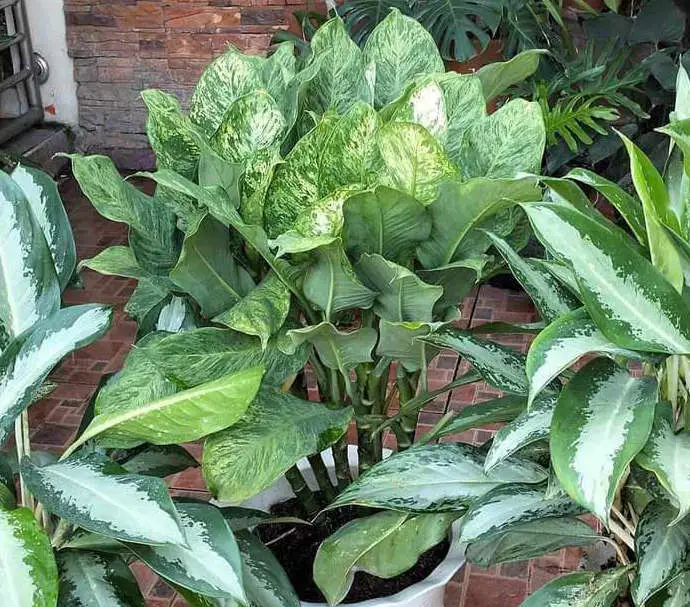Calathea and prayer plants are two of the most popular houseplants in the world. But some people wonder, “are calathea and prayer plants the same?” In this blog post, we will answer that question for you as well as give you some tips on how to care for these plants.
Is a Calathea the Same as a Prayer Plant?
No, prayer plants are marantas, not calatheas. Prayer plants perform nyctinasty (leaves close at night), which calatheas do not do. This is the main way to distinguish these two plants.
However, there is some overlap in the care requirements for calatheas and prayer plants. Both like high humidity, bright light (but not direct sun), and moist but not wet soil.
They are also both members of the Marantaceae family! Although are different genus and species, they are still closely related and make great companions in the home.
If you’re having trouble distinguishing between a calathea and a prayer plant, just remember that nyctinasty (closing at night) is the key difference! Both plants are beautiful and easy to care for, so you can’t go wrong with either one.
What is a Prayer Plant?
Prayer plants are members of the Marantaceae family. They get their name from their ability to close their leaves at night, which resembles a person in prayer. They are also commonly called Maranta plants or Zebra plants because of the white veins on their green leaves.
Prayer plants are native to tropical rainforests and swamps in South America. However, you can grow them indoors with ease! Prayer plants make beautiful houseplants because of their bright green leaves and easy care requirements.
There are more than 40 different species of maranta plant, although only a few of them will be found at your local garden center. The three most common types are the red, green, and black prayer plants.
Maranta and Calathea Similarities
As they are both from the family Marantaceae, there are some similarities between calatheas and prayer plants. Both like high humidity, bright light (but not direct sun), and moist but not wet soil. They also both grow well in tropical environments, making them a perfect choice for indoor gardening.
In regards to the appearance of the plants, they are also similar. Both calathea and maranta have beautiful leaves with a similar pattern. This pattern tends to look like small stripes that are dark green in color.
In fact, this is why many people think they are the same plant! They see the unique leaf pattern and automatically assume both plants are one and the same.
Maranta and Calathea Differences
Captive calatheas tend to be more colorful and diverse than Marantas. Their colors can vary from bright shades to dark hues, making them stand out in your garden or landscape even when they’re not growing alone!
Also, calatheas are not known for closing their leaves at any point. In contrast, prayer plants have the ability to close their leaves during the night or when they’re exposed to sudden light or temperature changes.
In addition, calatheas tend to grow bushier and taller than prayer plants, making them a better choice for outdoor gardens. Prayer plants typically grow more slowly and stay smaller when compared to other types of indoor houseplants.
Maranta make great hanging plants because of their cascading leaves. Calatheas, on the other hand, make more compact and bushy specimens that are perfect for planting in a pot or garden bed.
Care for Calathea and Maranta
The good news is that calatheas and marantas are some of the easiest houseplants to care for. They both like high humidity, bright light (but not direct sun), and moist but not wet soil.
Here are a few more specific tips for caring for calatheas and prayer plants:
– Both plants prefer tropical environments, so try to keep them in a room that is consistently warm or has a humidifier running nearby
– Give your plant plenty of bright light, but make sure it’s not in direct sunlight. A sunny windowsill is perfect!
– Keep the soil moist, but don’t let it get too wet or waterlogged. You can tell if the plant needs watering by feeling the soil – if it feels dry to the touch, then it’s time for a drink
– Fertilize your plant every few months with a balanced houseplant fertilizer
– Both plants can be susceptible to mealybugs and spider mites, so keep an eye out for any signs of pests and treat them accordingly
Conclusion
In conclusion, calatheas and prayer plants are two different types of plants. However, they both come from the same family (Marantaceae) and share some common care requirements. If you are looking for an easy-to-care-for houseplant with beautiful leaves, either a calathea or prayer plant may be a good choice for you!
Don’t be surpised if you see your maranta moving at night. It is named the “prayer plant” because it appears to fold its leaves as if in prayer when the sun goes down.
Which plants do you prefer? Personally, I like the calathea because there are so many varieties that you can own. In fact, I’m writing this just 1ft away from a calathea leopardina.
Thank you for reading my blog post on calatheas and prayer plants. I hope you found this information helpful! I’ve also written many posts about the wonderful calathea, so please do check them out.
Tim is an avid gardener from the UK. He was the founder of PlantCarer.com from 2021 to Sep 2023. He sold PlantCarer.com to Aaron. He has since started his own business called Seed To Supper, which provides new gardeners all the materials you need in a box (pots, seeds, compost and instructions) to grow your own delicious and nutritious vegetables and herbs from start to finish – no garden required.






0 Comments